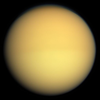Wikipedia:Today's featured article/March 13, 2012
Titan is the largest moon of Saturn, the only natural satellite known to have a dense atmosphere, and the only object other than Earth for which clear evidence of stable bodies of surface liquid has been found. Discovered on 25 March 1655 by the Dutch astronomer Christiaan Huygens, Titan is the sixth ellipsoidal moon from Saturn. Frequently described as a planet-like moon, it is the second-largest natural satellite in the Solar System, after Jupiter's moon Ganymede, and it is larger by volume than the smallest planet, Mercury. Titan itself is primarily composed of water ice and rocky material. Its dense, opaque atmosphere meant that little was known of the surface features or conditions until the Cassini–Huygens mission in 2004. Although mountains and several possible cryovolcanoes have been discovered, its surface is relatively smooth and few impact craters have been found. Owing to the existence of stable bodies of surface liquids and its thick nitrogen-based atmosphere, Titan has been cited as a possible host for microbial extraterrestrial life or, at least, as a prebiotic environment rich in complex organic chemistry. (more...)
Recently featured: Birth control movement in the United States – Gorgosaurus – Baker Street and Waterloo Railway
